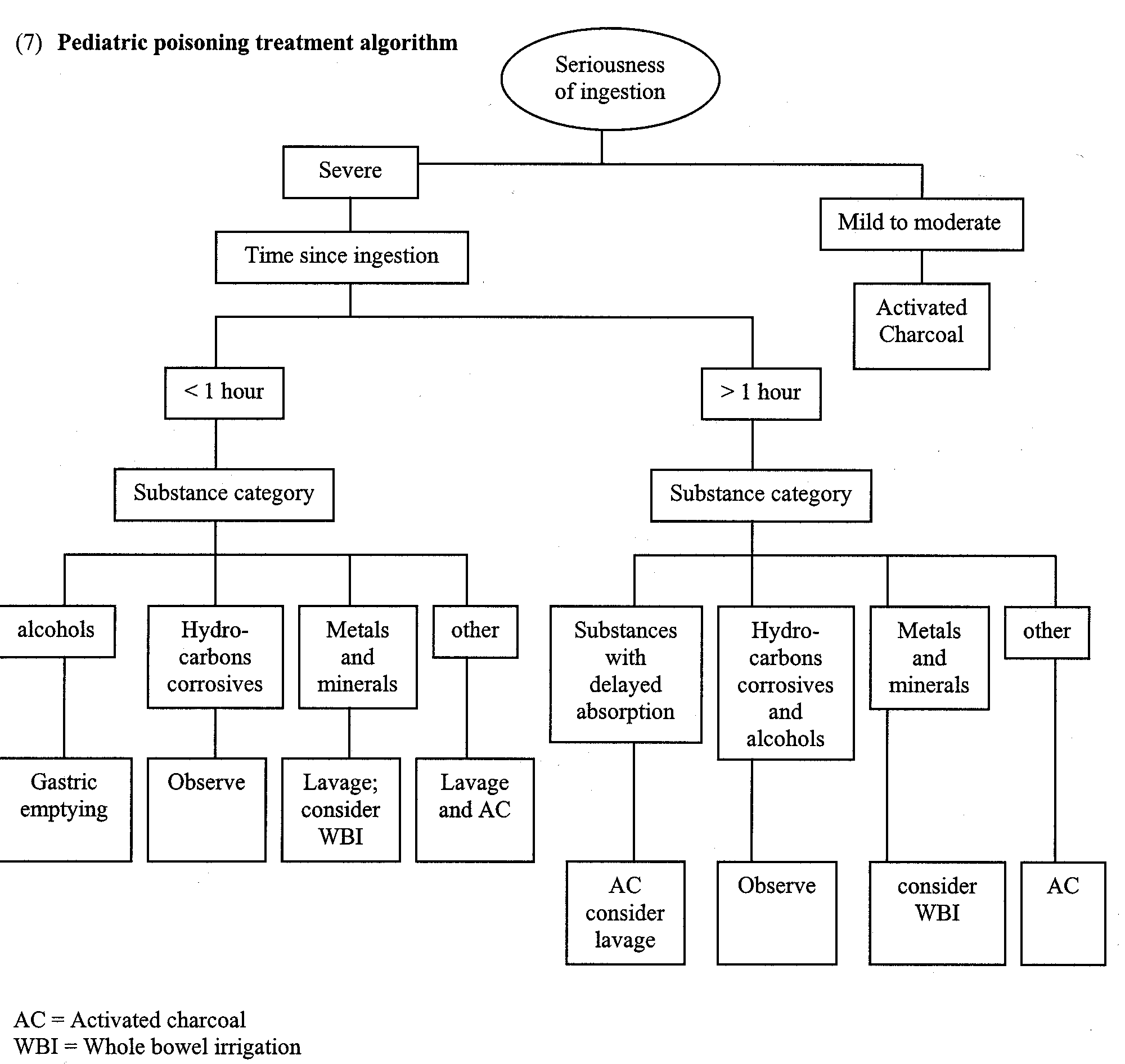Pediatric Poisoning
|
Patients less than 17 years of age account for 66 percent of reported exposures and 9 percent of all fatalities from poisoning. Medications, including iron, alcohol, hydrocarbons, and carbon monoxide are some of the most common and serious agents; the kitchen and the bathroom are the locations where most ingestion in children occur. Patients present an average of 68 minutes after the ingestion.
If the patient has a depressed mental status
Dextrostix, serum glucose, electrolytes, monitor/EKG, toxicology of blood/serum/vomitus, arterial blood gas (ABG), abdominal films. Especially look for arrhythmias, metabolic acidosis, seizures, and GI disturbance. Traditional methods of lavage, catharsis, and activated charcoal are undergoing reassessment; each has benefits and risks that apply to individual cases. Before choosing an intervention, the physician must determine:
Decontamination Clinical studies to compare efficacy of techniques are limited. Syrup of Ipecac and lavage are considered to have generally equal efficacy in clearing the stomach; activated charcoal is the most frequently used and the most effective decontamination agent. Certain patients can be treated appropriately without gastric emptying and with activated charcoal only. Syrup of Ipecac This should not be used routinely. Dose: 6-12months, 10 cc; 1-10years of age, 30cc; follow with water; induces emesis within 20-60 minutes. Disadvantages:
Advantages:
Lavage 36-40 F orogastric tube. Can use in any patient with a potentially toxic ingestion, in whom toxin may still be present, where procedure can be done safely. If the mental status is depressed, you must intubate first to prevent aspiration. Activated Charcoal
Multiple dose regimen: Can increase adsorptive capacity, prevent reabsorption of poison in enterohepatic circulation, and enhance elimination with gut dialysis (creates concentration gradient):
Acetaminophen overdose. Although charcoal may bind N-acetylcysteine (NAC), there is no evidence that activated charcoal inhibits efficacy. Activated charcoal can be alternated Q2 hr with NAC, each at its own 4-hr interval. Treatment with NAC has priority over treatment with activated charcoal in a patient with a toxic acetaminophen level. Used safely in surgical preps, e.g., Golytely, Colyte; 0.5L/hr for a small child, 2 L/hr for a teen, until clear (4-6 L per hr). This treatment can be considered for patients who ingest a substance that is absorbed by charcoal; massive ingestion; or patients who don't tolerate charcoal. Pediatric poisoning treatment algorithm
Remember
Reviewed by CDR Wendy Bailey, MC, USN, Pediatric Specialty Leader, Naval Medical Center San Diego, San Diego, CA (1999). |
Preface · Administrative Section · Clinical Section
The
General Medical Officer Manual , NAVMEDPUB 5134, January 1, 2000
Bureau
of Medicine and Surgery, Department of the Navy, 2300 E Street NW, Washington, D.C.,
20372-5300
This web version of The General Medical Officer Manual, NAVMEDPUB 5134 is provided by The Brookside Associates Medical Education Division. It contains original contents from the official US Navy version, but has been reformatted for web access and includes advertising and links that were not present in the original version. This web version has not been approved by the Department of the Navy or the Department of Defense. The presence of any advertising on these pages does not constitute an endorsement of that product or service by either the Department of Defense or the Brookside Associates. The Brookside Associates is a private organization, not affiliated with the United States Department of Defense. All material in this version is unclassified. This formatting © 2006 Medical Education Division, Brookside Associates, Ltd. All rights reserved.
Home · Textbooks and Manuals · Videos · Lectures · Distance Learning · Training · Operational Safety · Search
This website is dedicated to the development and dissemination of medical information that may be useful to those who practice Operational Medicine. This website is privately-held and not connected to any governmental agency. The views expressed here are those of the authors, and unless otherwise noted, do not necessarily reflect the views of
the Brookside Associates, Ltd., any governmental or private organizations. All writings, discussions, and publications on this website are unclassified.
© 2006 Medical Education Division, Brookside Associates, Ltd. All rights reserved
Other Brookside Products
